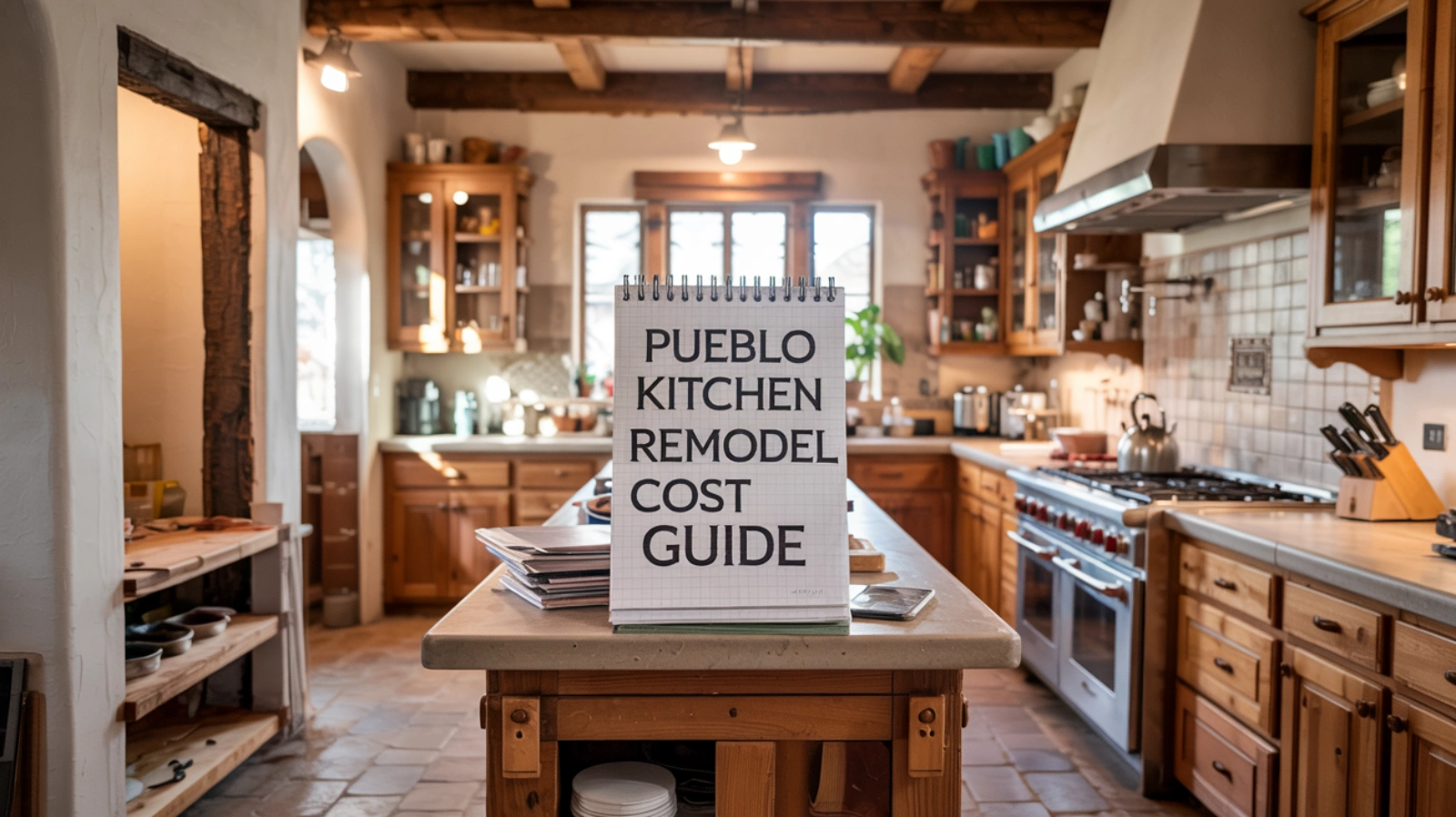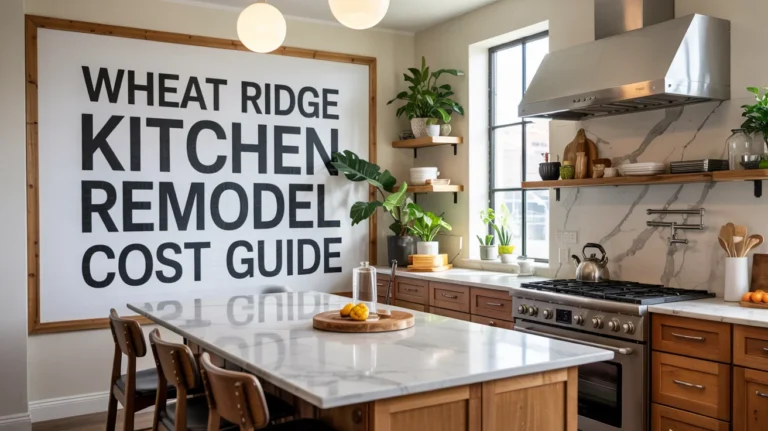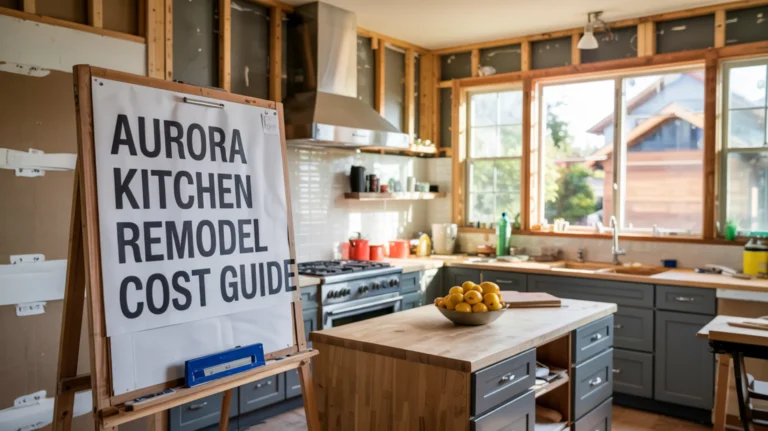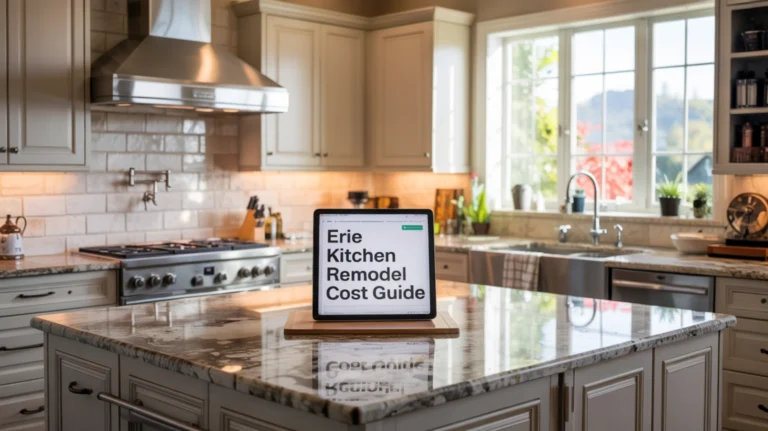Pueblo homeowners enjoy a hidden advantage with kitchen renovations—labor rates running 15% below state averages while Mountain Region remodels deliver impressive ROI. The catch? Material costs run slightly above average, so your real savings come from installation efficiencies and smart local sourcing.
So what will your Pueblo kitchen remodel actually cost you in 2025?
The average kitchen remodel cost in Pueblo, Colorado ranges from $12,000 to $35,000. Small projects with basic updates may cost as little as $8,000, while full remodels with premium finishes and layout changes can exceed $45,000 depending on labor and material choices.
Kitchen Remodel Cost Estimator for Pueblo
Pueblo Kitchen Remodel Cost Calculator
Get an estimate for your kitchen renovation based on your specifications.
Estimated Kitchen Remodel Cost
This estimate is based on national averages and may vary based on your location, material availability, contractor rates, and other factors. Prices are estimates only and should be used for planning purposes.
Looking for more accurate costs in your area? Search for location-specific remodel costs.
Kitchen Remodel Cost Analysis: Pueblo, Colorado

Ever wondered what actually goes into the price tag of a kitchen remodel? In Pueblo, Colorado, several key elements determine your bottom line. Understanding these components is your first step toward smart budgeting and planning.
Labor Costs
When you’re remodeling a kitchen, labor often takes a bigger bite of your budget than you might expect. We’re talking about 15% to 40% of your total project cost, based on national figures.
What’s included in this labor cost? Everything from demolition to installing cabinets, countertops, flooring, and appliances – not to mention specialized plumbing and electrical work. And if you bring in a general contractor to oversee everything? Add another 10% to 20% to your subtotal for their management services.
Here’s where Pueblo offers a distinct advantage.
Labor rates in Pueblo run noticeably lower than state and national averages. Data from 2023 shows construction workers in the Pueblo area earned an average of $27.53 per hour – below the national average of $29.57 for the same period.
Looking at more recent data from early 2025, general construction laborers in Pueblo typically earn between $20.56 and $21.00 hourly. Even the upper range (75th percentile) sits at just $21.49 – still under the Colorado state average of $22.01 for similar positions.
Specialized trades command higher rates, of course.
Electricians in Pueblo earn around $33.55 per hour (plus benefits), while carpenters performing form work make about $19.00 hourly (plus benefits), according to 2025 Davis-Bacon wage determinations. Hiring a general contractor? Daily rates typically fall between $300 and $500, plus costs for any additional workers.
This advantage is confirmed by industry data. The 2019 RSMeans City Cost Index showed Pueblo’s installation costs running just 0.14% above the national baseline – far better than the 30-city average increase of 1.20%.
What does this mean for your kitchen project?
Even though a general contractor will still charge that standard 10-20% fee, they’re applying it to a lower base cost in Pueblo. Your labor dollars simply stretch further here compared to Denver, Colorado Springs, or most major metro areas.
This labor advantage could be your opportunity to either save money or upgrade to better materials without breaking your budget.
Material Costs
While labor costs give Pueblo homeowners an edge, what about materials? This is where your personal choices dramatically impact your bottom line.
National trends show material prices climbing recently. According to the 2019 RSMeans City Cost Index, Pueblo’s material costs run slightly above the 30-city average (+5.17% versus +4.20%). So while you might save on labor, don’t expect significant discounts on materials compared to other markets.
Cabinets
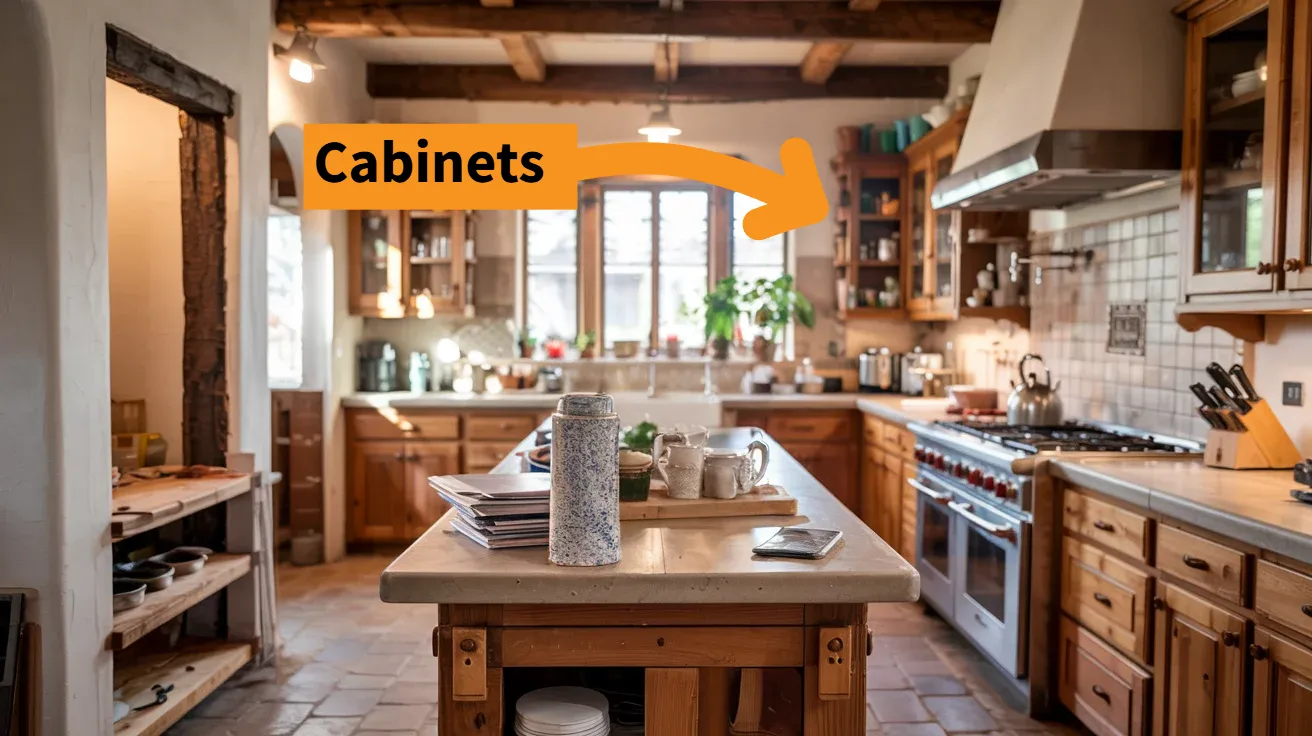
Did you know cabinets often represent the single biggest material expense in your kitchen remodel? In a typical mid-range project, they can consume about 28% of your budget – think $8,400 in a $30,000 remodel. Cabinet costs are usually measured per linear foot, and they fall into three distinct categories:
%%{init: {'theme': 'neutral'}}%%
graph TD
A[Cabinet Type] --> B(Stock);
A --> C(Semi-Custom);
A --> D(Custom);
B --> B1{Cost: $100-$400/lin ft};
C --> C1{Cost: $150-$700/lin ft};
D --> D1{Cost: $500-$1200+/lin ft};
style A fill:#f9f,stroke:#333,stroke-width:2px
style B fill:#ccf,stroke:#333,stroke-width:1.5px
style C fill:#ffcc99,stroke:#333,stroke-width:1.5px
style D fill:#ccffcc,stroke:#333,stroke-width:1.5px
style B1 fill:#FFFFE0,stroke:#333,stroke-width:1.5px
style C1 fill:#FFFFE0,stroke:#333,stroke-width:1.5px
style D1 fill:#FFFFE0,stroke:#333,stroke-width:1.5pxStock Cabinets: The budget-friendly option.
These mass-produced cabinets come in standard dimensions with limited style choices. National estimates put installed costs between $100 and $400 per linear foot, with material-only costs ranging from $50 to $280.
Basic options start as low as $60-$70 per linear foot, which might mean just $1,500-$5,000 for your entire kitchen.
Pueblo has an interesting advantage here. Local suppliers like Cabinet Warehouse offer American-made (Amish) Kountry Wood Cabinets that are pre-assembled and in-stock. This gives you immediate availability and competitive pricing without sacrificing quality. Big-box stores like Home Depot provide additional in-stock options.
Semi-Custom Cabinets: The middle ground.
Want more style options and modification possibilities? Semi-custom cabinets bridge the gap between budget and full customization.
Nationally, expect to pay $150 to $700 per linear foot installed, with material-only costs between $400 and $650 per linear foot. Your total cabinet bill might land between $3,000 and $12,000.
Pueblo residents can find these through local dealerships and design centers, giving you plenty of options to explore.
Custom Cabinets: The premium choice.
Created precisely to your specifications, custom cabinets offer maximum design flexibility and unique configurations – at a price. National installed costs average $500 to $1,200 per linear foot.
Material costs vary dramatically based on what you choose. MDF might run $300-$400 per linear foot, while cherry wood jumps to $500-$700. Depending on your kitchen size and design complexity, custom cabinets could cost anywhere from $12,000 to over $36,000.
Don’t forget installation labor, which adds $50 to $450 per linear foot depending on cabinet type and complexity. Home Depot estimates a narrower range of $69-$119 per linear foot for installation.
One distinct Pueblo advantage? Those local suppliers offering pre-assembled, in-stock cabinets – including quality Amish-made options. This availability gives Pueblo homeowners access to durable, ready-to-install cabinets without the wait times or quality compromises found in markets more dependent on ready-to-assemble (RTA) options.
Countertops
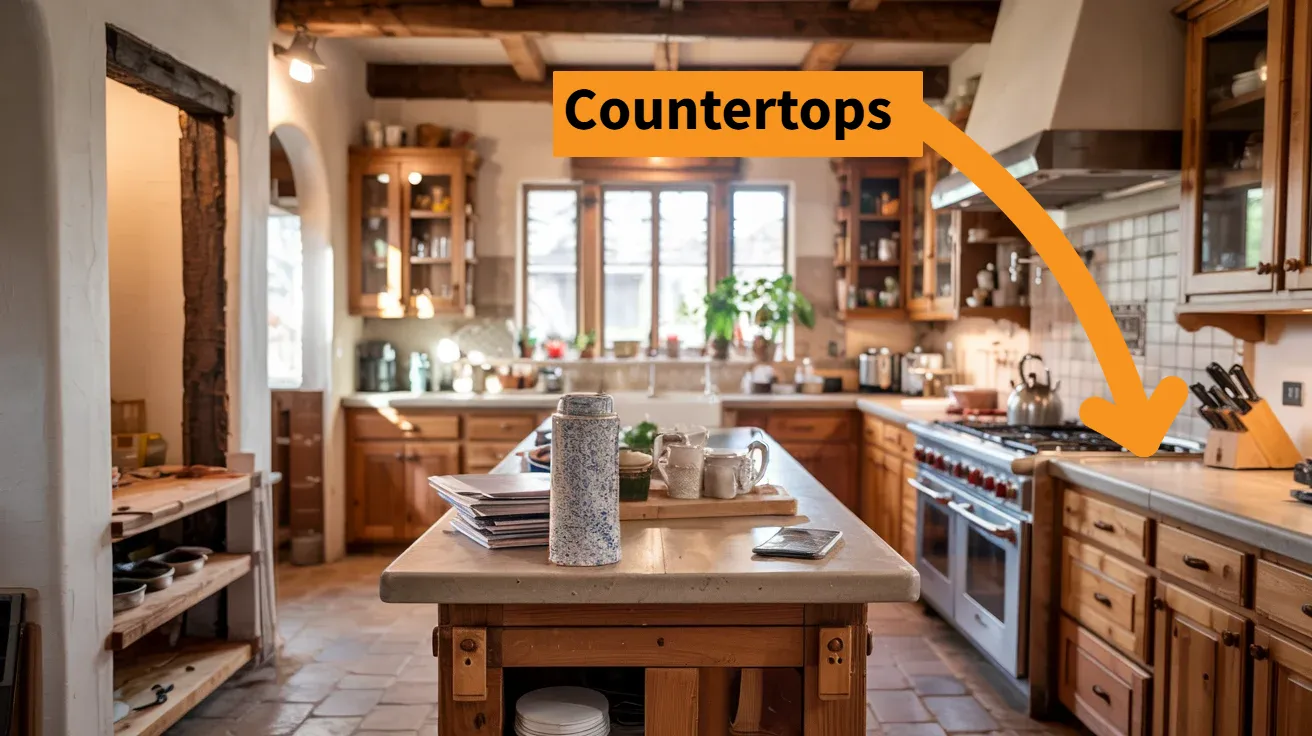
Your countertop choice dramatically impacts both your budget and your kitchen’s appearance. Costs vary widely based on the material, quality grade, edge treatments, and any cutouts needed for sinks or cooktops. Installation is typically factored into the per-square-foot price or added separately.
Here’s where things get interesting for Pueblo homeowners:
Granite: The perennial favorite.
In Pueblo specifically, ProMatcher data shows an average installed cost of $76.42 per square foot for Level 1 granite (ranging from $72.12-$80.72).
This is significantly lower than both the Colorado statewide average of $90.63 and the Denver-area average of $91.38 per square foot. That’s a 15-20% savings just for being in Pueblo!
Broader Colorado estimates place granite material costs between $40 and $200 per square foot, while Denver material costs run $45-$75 per square foot. National averages hover around $70 per square foot for material alone.
Different granite types command different prices – Alaska White averages around $35/sq. ft., while Absolute Black ranges from $45-$60/sq. ft. Installation typically adds $30-$50 per square foot to these material prices.
For Pueblo homeowners, having local fabricators like Sol Granite operating directly in town helps keep these costs competitive.
Quartz: The engineered alternative.
Known for durability and low maintenance, quartz offers another compelling option. Pueblo’s average installed cost is $69.34 per square foot (ranging from $60.78-$77.90).
Again, this compares favorably to the Colorado statewide average of $82.23 per square foot – about 16% savings. National material costs range from $50 to $120 per square foot, with an average around $80 per square foot.
Laminate: The budget option.
If you’re watching pennies, laminate delivers the best value. Pueblo’s average installed cost is $33.82 per square foot (ranging from $30.82-$36.81), slightly below the Colorado statewide average of $40.10 and close to the national average of $34.
Marble: The luxury choice.
For high-end kitchens, marble makes a statement. In Pueblo, expect an average installed cost of $105.29 per square foot (ranging from $98.44-$112.14), significantly below the Colorado statewide average of $124.86.
Prices vary dramatically by marble type – Carrara runs around $40/sq. ft., while Calacatta can reach $180/sq. ft.
Other Materials in Pueblo (Average Installed Costs):
- Solid Surface (e.g., Corian): $46.69/sq. ft.
- Tile: $13.89/sq. ft.
- Concrete: $80.25/sq. ft.
- Stainless Steel: $85.60/sq. ft.
- Wood: $37.57/sq. ft.
- Recycled Glass: $68.25/sq. ft.
Don’t forget to budget for extras. Edge treatments add $5 to $30 per linear foot depending on complexity. While standard sink cutouts are usually included, more intricate shapes cost extra. Removing old countertops typically runs $8-$13 per square foot, while sealing granite adds approximately $10-$20 per square foot. Plumbing disconnection and reconnection for sink replacement averages around $550.
The direct comparison between Pueblo and statewide prices reveals a significant advantage. Granite and quartz – probably the two most popular mid-to-high-end options – cost 15-16% less in Pueblo than the Colorado average.
What’s the real-world impact? You might be able to upgrade to granite or quartz in Pueblo at a price that would only allow for lower-tier materials elsewhere in Colorado. That’s a tangible quality-of-life improvement courtesy of Pueblo’s market dynamics.
Flooring

Your kitchen floor needs to handle everything from spilled pasta sauce to dropped pans – all while looking fantastic. Flooring costs depend primarily on your material choice, installation complexity, and subfloor condition.
Luxury Vinyl Plank/Tile (LVP/LVT): The practical performer.
LVP has skyrocketed in popularity thanks to its durability, water resistance, and ability to mimic more expensive materials like hardwood or stone.
Colorado’s average installed cost for vinyl flooring sits at $3.63 per square foot (ranging from $3.20-$4.06). Nationally, material costs show tremendous variation – from $1-$3 per square foot for standard sheet or plank vinyl to under $1 for budget options, while premium LVP can exceed $6.50 per square foot.
Installation labor typically adds $1-$3 per square foot nationally. Pueblo resources include specialty suppliers like The Tile House and dedicated installers such as Footprints Floors.
One documented small project (51 sq ft) in Pueblo West through Home Depot came to $913 total – approximately $18 per square foot. That high per-square-foot cost likely reflects minimum job charges or extensive subfloor preparation rather than typical pricing.
Tile (Ceramic/Porcelain): The classic kitchen option.
Durable and water-resistant, tile remains a kitchen staple. National estimates place total installed costs for basic vinyl or laminate flooring between $500-$1,500, while luxury materials like slate can drive totals toward $5,000-$32,000.
Given that tile countertop installation in Pueblo averages $13.89 per square foot, floor tile installation might fall into a similar or moderately higher cost bracket. The Tile House serves as a key local supplier for Pueblo residents seeking tile flooring options.
Hardwood/Engineered Wood: The premium choice.
Generally more expensive than the alternatives, hardwood brings warmth and character to a kitchen. National total cost estimates range from $2,500-$7,000. Colorado-specific data suggests installation costs between $6.70 and $9.40 per square foot.
Across all materials, the national cost range for flooring installation typically falls between $1,520 and $4,700, with actual labor costs heavily dependent on your chosen material and existing subfloor condition.
When budgeting, don’t just consider the initial cost. Think about durability in a high-traffic, high-spill environment like a kitchen. A slightly higher investment might deliver years of additional service life – as anyone who’s dealt with warped laminate around a dishwasher can attest!
Appliances and Fixtures

Appliances: From basic to chef-worthy.
The price spectrum for kitchen appliances stretches wider than you might imagine, governed by brand reputation, technology features, energy efficiency, and finish choices. Individual appliances range from as little as $200 to well over $10,000.
What should you budget for a complete set? A standard suite of mid-range appliances – refrigerator, range, dishwasher, and microwave – typically runs between $4,500 and $6,000. Energy Star certified models often command a premium but offer potential long-term savings on utility bills.
Don’t forget installation costs. Professional installation adds typically $120 to $280 per appliance to your budget.
Fixtures (Sink, Faucet, Lighting): The finishing touches.
These elements might seem minor compared to big-ticket items like cabinets, but they add up quickly and dramatically impact your kitchen’s functionality and feel.
Sink installation generally costs between $220 and $630. Faucet installation typically ranges from $160 to $360.
Lighting deserves special attention in your planning. Installing recessed lighting, a popular choice for modern kitchens, can cost around $300 per fixture. For a mid-range remodel, you might allocate approximately $1,500 total for lighting.
These seemingly small details often make the biggest difference in how your kitchen feels to use. A quality faucet with the right features can make daily tasks more pleasant, while thoughtful lighting transforms both the function and mood of your space.
Permitting Fees
Think you can skip permits for your kitchen remodel? Think again. Obtaining necessary permits from the Pueblo Regional Building Department (PRBD) isn’t just legally required – it ensures your renovation meets safety standards and won’t cause problems when you eventually sell.
PRBD oversees building code enforcement and permit issuance for both the City and County of Pueblo. Their permit fees are primarily calculated based on your project’s total valuation – including both labor and materials.
How do these fees work? They follow a tiered schedule outlined in PRBD documentation. For small projects valued up to $500, you’ll pay a flat fee of $33.08. Above that, fees increase based on valuation brackets.
Let’s look at some real examples based on the 2016 fee schedule:
- A $15,000 kitchen refresh incurs a permit fee of $195.11 ($66.15 for the first $2,000 + 13 increments of $1,000 at $9.92 each)
- A $30,000 mid-range remodel costs $330.22 in permit fees ($294.37 for the first $25,000 + 5 increments of $1,000 at $7.17 each)
- A $60,000 upscale renovation requires $523.32 in permit fees ($473.62 for the first $50,000 + 10 increments of $1,000 at $4.97 each)
Beyond these valuation-based fees, PRBD lists fixed fees for specific residential permits related to single trades. Upgrading electrical service costs $55.13, replacing a water heater runs $44.10, and connecting an air conditioner adds $44.10.
If these specific tasks are part of your larger kitchen project, these fixed fees may add to your main building permit fee.
One more thing to note: builders affiliated with the Pueblo Association of Home Builders (PAHB) face an additional assessment of $30.00 per permit.
Here’s a quick reference table for kitchen remodel permit fees in Pueblo:
Example Permit Fees for Pueblo Kitchen Remodel Valuations
| Project Valuation | Calculated Building Permit Fee (Based on PRBD 2016 Schedule, Table B) | Notes |
|---|---|---|
| $15,000 | $195.11 | Represents baseline building permit fee based on total job cost. Excludes potential plan review fees or separate fixed fees for extensive electrical/plumbing upgrades not covered under the main valuation. |
| $30,000 | $330.22 | Represents baseline building permit fee based on total job cost. Excludes potential plan review fees or separate fixed fees for extensive electrical/plumbing upgrades not covered under the main valuation. |
| $60,000 | $523.32 | Represents baseline building permit fee based on total job cost. Excludes potential plan review fees or separate fixed fees for extensive electrical/plumbing upgrades not covered under the main valuation. |
While permit fees might seem like an annoying extra expense, they typically represent just 1-2% of your total project cost – a small price to pay for ensuring work is done safely and to code.
Design and Contractor Fees
Design Fees: Worth the investment?
While not essential for simple renovations, professional kitchen designers can dramatically improve both functionality and aesthetics. Think of them as translators between your lifestyle needs and the physical space.
Design fees vary based on the designer’s experience and your project’s scope. National estimates suggest design fees might run around $900 for a typical mid-range project, but this can fluctuate significantly depending on complexity and service level.
Is this worth it? Consider that a kitchen designer might help you avoid costly mistakes, maximize storage in unexpected ways, and create a more efficient workflow – potentially saving you both money and daily frustration.
General Contractor (GC) Fees: The project quarterback.
For comprehensive remodels involving multiple trades, a general contractor provides crucial project management, scheduling, and oversight. They’re the single point of contact coordinating all the moving parts.
How do they charge? Typically as a percentage of your total project cost, commonly ranging from 10% to 20%. On a $30,000 kitchen, that’s $3,000-$6,000.
Alternatively, some GCs charge based on daily rates – nationally estimated at $300-$500 per day for the GC, plus $150-$250 per day for each additional laborer assigned to your project.
While this might seem like a substantial premium, good contractors earn their fee by preventing expensive mistakes, negotiating better prices with subcontractors, handling unexpected issues, and keeping your timeline on track. For anything beyond a simple refresh, this coordination often proves invaluable.
Key Performance Indicators (KPIs) for Pueblo Kitchen Remodels
How do you know if you’re getting a fair price on your kitchen renovation? Establishing key performance indicators (KPIs) helps you compare and evaluate costs within the Pueblo market.
The two most useful KPIs are cost per square foot and typical cost ranges by project scope.
Average Cost Per Square Foot Ranges
Cost per square foot gives you a normalized metric for comparing projects of different sizes. National benchmarks show wide variation, typically $75 to $250 per square foot, depending heavily on scope and material choices. Some sources suggest $100-$250 per square foot may be applicable in markets like Pueblo.
For context, general home remodeling in Pueblo has been estimated broadly between $10 and $60 per square foot, with similar figures ($15-$60/sq. ft.) cited for Denver. While these represent overall remodeling rather than kitchen-specific work, they provide a lower boundary.
At the upper end, new home construction in Colorado averages around $250 per square foot, offering a reference point for what complete rebuilding might cost.
To estimate kitchen-specific costs, we can divide typical project totals by average kitchen sizes. For instance, a nationally averaged $26,972 remodel in a 150 sq. ft. kitchen implies approximately $180 per square foot.
Based on these benchmarks, local remodeling data, and new construction costs, here’s an estimated breakdown for Pueblo:
Pueblo Kitchen Remodel Cost per Square Foot by Scope (Estimated)
| Project Scope | Estimated Cost per Square Foot (Pueblo, CO) | Basis & Influencing Factors |
|---|---|---|
| Minor Remodel | $75 – $150 | Primarily cosmetic updates (e.g., paint, hardware refresh, cabinet refacing), utilizing stock-grade materials, and maintaining the existing kitchen layout. This range aligns with the lower end of national kitchen remodel estimates and overlaps with general Pueblo remodeling cost data. |
| Mid-Range Major Remodel | $150 – $250 | Involves replacing major components like appliances and flooring, installing new semi-custom cabinets, and using quality countertops (e.g., granite, quartz). May include minor adjustments to the layout. This range reflects typical national averages for major remodels and common project budget examples. |
| Upscale Major Remodel | $250 – $400+ | Features high-end elements such as custom cabinetry, premium or commercial-grade appliances (e.g., Sub-Zero, Wolf), luxury materials (e.g., marble, exotic woods), significant layout reconfigurations, and potentially structural modifications. Costs exceed typical national averages and approach per-square-foot costs associated with new home construction. |
This standardized metric helps you compare options across different kitchen sizes and project ambitions specifically within the Pueblo market.
Typical Cost Ranges by Project Scope
Your budget expectations should vary significantly based on how extensive your renovation will be and the size of your kitchen. Let’s break down the typical project scopes:
Minor Remodel: The refresh approach.
This focuses on updating your kitchen’s appearance without changing the layout. Typically includes painting, new flooring, replacing some appliances with energy-efficient models, and updating cabinet fronts (refacing) or installing entry-level stock cabinets.
The national average cost for a minor remodel was around $27,492 according to the 2024 Cost vs. Value report.
Mid-Range Major Remodel: The substantial update.
This involves a more comprehensive overhaul, including new semi-custom cabinetry, new appliances, quality countertops (granite or quartz), new flooring, and fixtures. You might make minor layout adjustments.
The national average cost for this scope was approximately $79,982 in 2024. Many homeowners find budgets around $30,000 sufficient for a functional mid-range update in smaller kitchens.
Upscale Major Remodel: The complete transformation.
This represents a top-to-bottom renovation with high-end materials and features. Expect custom cabinetry, premium or commercial-grade appliances, luxury countertops and flooring, sophisticated lighting, and often significant layout changes, possibly including structural work.
The national average cost for an upscale remodel reached $158,530 in 2024.
How does kitchen size affect these numbers? Dramatically.
Smaller kitchens (under 100 sq ft) naturally cost less overall, potentially ranging from $5,000 to $20,000 depending on scope. Medium kitchens (100-200 sq ft) might run from $11,250 to $50,000. Large kitchens (over 200 sq ft) require more materials and labor, pushing costs from $15,000-$50,000+ up to $30,000-$75,000 or more for extensive renovations.
Given Pueblo’s lower labor costs combined with roughly average material costs, your overall project might run slightly below these national figures, particularly for mid-range and upscale projects where labor constitutes a larger budget percentage.
A common budgeting guideline suggests allocating 5-15% of your home’s value toward a kitchen remodel. For a $300,000 Pueblo home, that means $15,000-$45,000 – a reasonable starting point for planning.
Based on all these factors, here’s what Pueblo homeowners might expect to pay:
Pueblo Kitchen Remodel Cost Ranges by Scope and Size (Estimated)
| Kitchen Size | Minor Remodel Cost Range | Mid-Range Major Cost Range | Upscale Major Cost Range |
|---|---|---|---|
| Small (<100 sq ft) | $10,000 – $20,000 | $20,000 – $35,000 | $35,000 – $60,000+ |
| Medium (100-200 sq ft) | $15,000 – $25,000 | $30,000 – $60,000 | $60,000 – $100,000+ |
| Large (200+ sq ft) | $20,000 – $30,000 | $45,000 – $75,000 | $90,000 – $150,000+ |
These ranges reflect Pueblo’s unique market conditions, adjusting national figures based on local cost dynamics to give you realistic planning targets.
Return on Investment (ROI) in the Pueblo Market
Will you recoup your kitchen renovation costs when selling your home? This financial return, or Return on Investment (ROI), matters to many homeowners considering a remodel.
Estimated ROI Percentages
Specific ROI data for kitchen remodels in Pueblo isn’t available in the most recent years. However, we can analyze the most geographically relevant information: data for the Mountain Region, which includes Colorado.
The 2024 Cost vs. Value report indicates that a major mid-range kitchen remodel in the Mountain region recouped an average of 67.2% of its cost upon resale. That’s actually better than the national average, suggesting updated kitchens hold significant value for homebuyers in this region.
While specific 2023 Mountain Region kitchen data wasn’t available, national trends that year showed particularly strong ROI for minor kitchen remodels, with recoupment rates between 90.2% and 96.1%.
Looking at historical Colorado data provides additional perspective. The 2019 Cost vs. Value report showed an 80.5% ROI for a minor kitchen remodel in Colorado, while 2014 data indicated an 83.5% ROI for the same project type.
The National Association of Realtors (NAR) offers a broader view, suggesting a national average cost recovery for kitchen remodels ranging from 57.4% to 62.1%.
Combining these sources gives us this estimated ROI breakdown:
Estimated ROI for Pueblo/Mountain Region Kitchen Remodels by Scope
| Project Scope | Estimated ROI % (Mountain Region/CO) | Data Source & Year | Notes |
|---|---|---|---|
| Minor Kitchen Remodel | 80.5% – 96.1% | CO 2019, CO 2014, US 2023 (multiple sources) | Historically demonstrates high ROI. Specific 2024 Mountain Region data point was not identified in source materials. National 2023 data suggests very strong recent performance. |
| Mid-Range Major Kitchen Remodel | 67.2% | Mountain Region 2024 | Represents a solid return, considered above the national average for this project type, indicating strong regional value. |
| Upscale Major Kitchen Remodel | 21.2% – 32.6% (Proxy based on Upscale Additions) | Mountain Region 2024 – Primary Suite Addition | Direct data for upscale kitchens is lacking in recent regional reports. Upscale projects generally yield lower ROI percentages. Figures use upscale primary suite additions as the closest available proxy from the 2024 regional report. |
Regional Market Context
The Cost vs. Value methodology compares average project costs with the value those projects retain at resale across 150 U.S. markets. These ROI figures fluctuate with economic conditions, material costs, and evolving buyer preferences.
Historically, exterior improvements like siding replacement, stone veneer, and garage door replacements often yield the highest percentage ROI. However, kitchen remodels consistently remain a high-priority item for homebuyers and significantly impact perceived home value.
The 2024 Mountain Region report also highlighted strong ROI for HVAC conversions and siding replacements alongside kitchen updates.
Specific economic factors in Pueblo, such as documented wage growth and a competitive construction market, shape the local remodeling environment. While direct Pueblo kitchen ROI data isn’t available, the robust figures for the Mountain Region strongly suggest well-executed kitchen remodels are favorably valued in the Southern Colorado real estate market.
The key takeaway? Minor kitchen remodels consistently offer the best financial return, often recouping 80-96% of their cost. Mid-range major remodels deliver solid but lower returns at around 67%. Upscale projects, while creating dramatic transformations, typically recover a smaller percentage of their substantial investment.
Regulatory Requirements in Pueblo
Thinking about skipping the paperwork for your kitchen remodel? That could cost you far more in the long run. Local building regulations and permits aren’t just bureaucratic hurdles – they’re legal requirements that protect both your safety and your investment.
Pueblo Regional Building Department (PRBD)
The Pueblo Regional Building Department (PRBD) serves as the authority responsible for enforcing building codes and issuing permits within both the City and County of Pueblo.
Contact Information:
- Address: 830 N Main St, Pueblo, CO 81003
- Phone: (719) 543-0002
- Website: www.prbd.com
- Permit Inquiries Email: [email protected]
Adopted Building Codes
Effective July 1, 2024, PRBD enforces these codes for residential construction, including kitchen remodels:
- 2021 International Residential Code (IRC)
- 2023 National Electrical Code (NEC)
- 2021 International Plumbing Code (IPC) (as adopted by the Colorado Plumbing Code)
- 2021 International Mechanical Code (IMC)
- 2021 International Fuel Gas Code (IFGC)
- 2021 International Energy Conservation Code (IECC)
The department also requires meeting specific local design criteria, including a 26-inch frost depth requirement and designing for Seismic Design Category B.
Permitting for Kitchen Remodels in Pueblo, CO
When do you need permits? Generally, they’re required for any work involving construction, enlargement, alteration, repair, movement, improvement, removal, conversion, or demolition of structures regulated by the adopted codes.
For kitchen remodels specifically, this means permits are necessary when:
- Altering the existing floor plan (moving walls, changing openings)
- Modifying electrical systems (adding circuits, relocating outlets/switches)
- Altering plumbing systems (moving supply or drain lines for sinks, dishwashers)
- Changing mechanical systems (altering ductwork for range hoods)
Minor cosmetic updates like painting or replacing cabinet hardware typically don’t require permits. However, replacing fixtures connected to plumbing or electrical systems (like sinks or dishwashers) usually does.
Not sure if your project needs a permit? Contact PRBD directly via email ([email protected]) or phone (719-543-0002).
The application process involves submitting appropriate forms. In Pueblo, building permits are typically issued only to licensed contractors responsible for the work. Homeowners performing the work themselves may qualify for permits using the Homeowner Permit Application form.
Even if your project is exempt from one type of permit (e.g., building), you might still need separate permits for mechanical, electrical, or plumbing work. Complex projects, especially those involving layout changes, may require submitting plans or drawings.
The regulatory framework scales with project complexity. While simple cosmetic updates might bypass the permit process, any work touching electrical, plumbing, or structural elements requires formal approval.
As your kitchen remodel grows from minor to mid-range or upscale, the permitting process becomes inherently more complex. This extends beyond just higher fees; it involves coordinating multiple trades under potentially separate permits and possibly navigating plan reviews.
The standard procedure of issuing permits to licensed contractors (with exceptions for homeowners) adds a layer of formality and potential expense compared to unregulated DIY work. Factor in not only the direct cost of permits but also the administrative overhead associated with a more involved regulatory process.
Material Quality and Performance Standards
Ever wonder why some kitchen remodels look tired after five years while others still shine after fifteen? The secret often lies in choosing materials that meet established industry standards for quality, safety, and durability.
Various organizations—including ANSI, AWI, ASTM, KCMA, and NSF—publish standards that separate genuinely quality materials from merely attractive ones.
Cabinetry Standards
Construction Quality: What’s hiding behind those cabinet doors matters tremendously.
Quality specifications often prioritize plywood construction over particleboard for cabinet boxes due to superior durability and moisture resistance. Detailed standards might specify material thicknesses (3/4-inch solid hardwood for face frames, 1/2-inch multi-ply plywood for end panels) and particular joinery techniques like dadoes, glue, and mechanical fasteners.
Certification: Looking for a shortcut to quality assurance?
The Kitchen Cabinet Manufacturers Association (KCMA) offers a certification program testing cabinets for structural integrity, drawer and door operation, and finish durability. Seeking KCMA-certified cabinets can provide confidence in your cabinetry’s quality and longevity.
Material Specifications: Common quality materials include solid hardwood, thermo-foil vinyl wraps over engineered wood cores, Linear Veneer Lumber (LVL), and various grades of multi-ply hardwood plywood.
Countertop Standards
Structural Performance: The ANSI/AWI 1236-2022 standard sets specific requirements that quality countertops must meet:
- Resistance to a 50 lb distributed load (over 144 sq. in.) with deflection not exceeding 0.250 inches
- Ability to support a 200 lb point load (over 86.4 sq. in., placed 3 inches from the front edge at mid-span) with deflection not exceeding 0.250 inches across the span
- Limitations on unsupported overhangs, generally not to exceed 12 inches from a support unless specifically engineered otherwise
- Detailed requirements for joints, edge profiles, and minimum radii for cut-outs (e.g., 0.250″ minimum radius)
These aren’t arbitrary numbers—they represent the difference between a countertop that sags over time and one that maintains its integrity for decades.
Material-Specific Requirements: The ANSI/AWI standard also addresses requirements for different countertop materials.
For laminates, this includes specifications for adhesive types (Type II), limitations on surface irregularities (“telegraphing”), and requirements for moisture-resistant substrates in areas prone to moisture, like around sinks. Similar detailed requirements exist for solid surface, natural/engineered stone, solid wood, and veneered wood countertops.
Sanitation Standards: NSF International provides standards relevant to food preparation surfaces.
NSF/ANSI 2 covers minimum food protection and sanitation requirements for food handling equipment. NSF/ANSI 35 specifically addresses sanitation requirements for high-pressure decorative laminates used as work surfaces on food service equipment.
Flooring Standards
Slip Resistance: Why does this matter in a kitchen? Think about spilled water, cooking oil, and other inevitable kitchen accidents.
ANSI A137.1 specifies that ceramic tiles intended for level interior floors expected to be walked upon when wet must meet a minimum wet Dynamic Coefficient of Friction (DCOF) of 0.42 when tested according to the ANSI A326.3 method. Higher DCOF values (≥ 0.60 or ≥ 0.65) are recommended for ramps, exterior areas, or areas potentially exposed to oils and greases.
Proper cleaning and maintenance are essential to preserve slip resistance over time.
Sanitation: For commercial settings and high-use residential kitchens, NSF/ANSI 52 establishes minimum public health requirements for supplementary flooring materials.
This standard focuses on ensuring flooring is easily cleanable, durable, resistant to moisture and chemicals, resistant to microbial growth, and doesn’t provide harborage for pests.
Material Composition and Safety: Standards like ANSI A208.1 (Particleboard) and ANSI A208.2 (MDF) define properties for composite wood products often used as substrates.
Additionally, regulations concerning formaldehyde emissions from composite wood products are important for indoor air quality, such as the California Air Resources Board Airborne Toxic Control Measure (CARB ATCM) referenced for bamboo flooring platforms.
The selection of kitchen materials involves a necessary balance between aesthetics and performance. Flooring choices must meet critical safety standards like slip resistance in potentially wet conditions. A highly polished tile might offer a desired sleek appearance, but its inherently lower DCOF can present a safety concern.
Similarly, countertop materials must satisfy structural load-bearing and deflection requirements, regardless of their visual appeal. Design choices cannot be made solely on looks; homeowners and designers must verify selected materials meet relevant safety and performance standards to ensure a functional, safe, compliant, and durable kitchen remodel.
Prioritizing aesthetics over established standards can lead to safety hazards, non-compliance, or premature material failure—turning your dream kitchen into a costly disappointment.
Pueblo-Specific Cost Influences
What makes remodeling a kitchen in Pueblo different from Denver or Colorado Springs? Beyond general market trends, specific local factors shape your final costs. These include Pueblo’s unique labor rates, material sourcing options, and regional design preferences.
Local Labor Rate Analysis
As detailed earlier, construction wages in Pueblo generally run lower than state and national averages—a significant cost advantage for homeowners.
Comparative Wages: Average hourly wages for general construction laborers in Pueblo (~$20.56-$21.00) fall below both the Colorado average ($22.01) and the national average for the broader Construction & Extraction sector ($29.57). Specific trade rates, like the union scale base rate for electricians ($33.55), provide additional local benchmarks.
Installation Cost Index: The 2019 RSMeans City Cost Index quantifies this advantage, showing Pueblo’s installation cost index increase (0.14%) was substantially lower than the 30-city average increase (1.20%) relative to the national baseline. This reinforces the potential for savings on labor components in Pueblo.
This table presents localized wage data for trades crucial to kitchen remodeling:
Average Hourly Wages for Key Construction Trades in Pueblo, CO (Approx. 2023-2025 Data)
| Trade / Role | Average Hourly Wage (Pueblo) | Comparison Data Source(s) | Notes |
|---|---|---|---|
| Construction Laborer (General) | $20.56 – $21.00 | ZipRecruiter, Mar 2025 | Typical range reported as $16.78-$21.49. |
| Construction & Extraction (Overall Sector) | $27.53 | BLS, May 2023 | Mean hourly wage for the entire occupational group in Pueblo MSA. |
| Electrician | $33.55 (Base Rate) | Davis-Bacon, Jan 2025 | Represents union scale; excludes fringe benefits ($15.71). Actual market rates may differ. |
| Carpenter (Form Work) | $19.00 (Base Rate) | Davis-Bacon, Jan 2025 | Represents union scale for form work; excludes fringe benefits ($5.88). Finishing carpenters typically command higher rates. |
| Plumber | $30.12 (State Avg) | General CO Data | Pueblo-specific rate not found; Colorado state average provided for context. |
Using this local data allows for more precise budgeting of the labor component compared to relying on national averages.
Material Availability and Pricing
The structure of Pueblo’s local market influences what materials cost and how easily you can get them. The city has a competitive construction market, which can contribute to more reasonable pricing overall.
A network of local suppliers serves the region’s remodeling needs:
Cabinets: Options range from value-oriented suppliers like Cabinet Warehouse (featuring in-stock, pre-assembled Kountry Wood Amish cabinets and semi-custom lines) and Home Depot to local design centers and builders’ suppliers, including several members of the Pueblo Association of Home Builders (PAHB) such as Oino Kitchen Center, Colorado Cabinet Works, and JKe Kitchen & Design Center.
Countertops: Pueblo hosts local fabricators like Sol Granite, alongside retailers like Tile House and installers accessible through platforms like Angi or HomeAdvisor. Several PAHB members also specialize in related materials (e.g., Summit Brick & Tile Co.).
Flooring: Suppliers include Tile House (offering tile and LVP), big-box stores like Home Depot and Lowe’s, specialized flooring retailers like Carpet One, installation services like Footprints Floors, and various PAHB member companies (e.g., Mountain View Flooring).
Regarding pricing, installed costs for popular countertop materials like granite and quartz appear lower in Pueblo compared to Colorado state averages. Pricing for materials like LVP varies dramatically depending on quality, brand, and source, from clearance prices under $1/sq ft to potentially $9-$15/sq ft for higher-end products or installations with significant preparation.
However, the 2019 RSMeans data indicated Pueblo’s overall material cost index was slightly higher than the 30-city average. This suggests that while local market competitiveness and lower labor rates contribute to savings on installed prices (especially for countertops), baseline material costs themselves may not be universally lower across all categories compared to other markets.
The real savings in Pueblo typically come through installation efficiencies and potentially specific local supplier pricing strategies rather than raw material costs.
Common Design Preferences
Kitchen design trends in Pueblo reflect the region’s Southwestern heritage, climate, and broader architectural styles. Popular approaches include:
Southwestern/Pueblo/Santa Fe: This style often incorporates earthy color palettes, terracotta tile flooring, architectural elements reminiscent of Kiva fireplaces or rounded corners, exposed wood beams (vigas), potentially textured wall finishes, and accents like colorful Mexican or Talavera tile backsplashes.
Common materials include granite countertops, wood cabinets (often in medium or dark stains), and sometimes concrete flooring.
Rustic/Farmhouse: Characterized by natural or reclaimed wood, a focus on comfort and warmth, and practical elements. Shaker-style cabinets or traditional raised-panel doors are frequent choices.
Contemporary/Modern: This approach favors clean lines, minimalism, smooth surfaces, and functionality. Flat-panel (slab) cabinet doors, quartz countertops, integrated high-tech appliances, and uncluttered layouts are hallmarks. Color palettes often involve white, gray, and light wood tones.
Transitional: This popular style effectively blends elements of traditional and contemporary design, aiming for a balanced aesthetic that is both warm and clean. It might involve mixing materials, such as pairing traditional wood cabinets with modern hardware or incorporating classic crown molding alongside sleek appliances.
Material choices reflect these styles. Granite remains a frequent countertop selection, suitable for Southwestern, Rustic, and Transitional kitchens. Terracotta and porcelain tile are characteristic flooring choices for Southwestern designs. LVP offers versatile wood or stone looks adaptable to nearly any style. Cabinet door styles vary accordingly, from raised-panel (Traditional, Southwestern) and Shaker (Transitional, Farmhouse) to flat-panel designs (Contemporary).
The prevalence of certain regional styles, particularly Southwestern or Pueblo-inspired designs, carries specific cost implications. Achieving an authentic look might require sourcing specific materials like genuine terracotta floor tiles, handcrafted decorative tiles for backsplashes, or custom wood cabinetry with particular finishes.
These specialized materials and the potential need for craftspeople skilled in traditional techniques could elevate costs compared to implementing more standardized Contemporary or basic Farmhouse designs using readily available stock components.
However, the relatively lower cost of granite in Pueblo aligns well with its frequent use in these regional aesthetics, potentially offsetting costs elsewhere. Homeowners pursuing a distinct Pueblo or Southwestern kitchen style should anticipate potentially higher budgets for unique materials and specialized labor, even while benefiting from local cost advantages on common elements like granite.
Opting for a more mainstream Transitional or Contemporary style utilizing locally sourced stock or semi-custom materials might offer more predictable cost control.
Conclusion
What’s your Pueblo kitchen remodel really going to cost?
For minor updates, expect $75-$150 per square foot. Mid-range renovations run $150-$250, while upscale transformations command $250-$400+.
Pueblo’s lower labor rates give you a distinct advantage over other Colorado cities—especially for larger projects where labor makes up a bigger slice of your budget.
The investment pays back, too. While Pueblo-specific data is limited, the Mountain Region shows kitchen remodels recover 67-96% of their cost at resale, with minor to mid-range projects delivering the strongest returns.
The key to success? Balance smart material choices with Pueblo’s unique market advantages, adhere to building codes, and choose materials that meet quality standards.
The result: a kitchen that enhances both your daily life and your home’s value for years to come.

